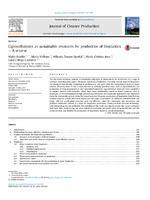| dc.creator | Brodin, Malin | |
| dc.creator | Vallejos, María Evangelina | |
| dc.creator | Opedal, Mihaela Tanase | |
| dc.creator | Area, María Cristina | |
| dc.creator | Chinga Carrasco, Gary | |
| dc.date.accessioned | 2023-01-30T13:31:17Z | |
| dc.date.available | 2023-01-30T13:31:17Z | |
| dc.date.issued | 2017-09-20 | |
| dc.identifier.citation | Brodin, M., Vallejos, M. E, Opedal, M. T., Area, M. C., y Chinga Carrasco, G. (2017). Lignocellulosics as sustainable resources for production of bioplastics : a review. Journal of Cleaner Production. Amsterdam, Países Bajos : Elsevier; 162, pp. 646-664. | es_AR |
| dc.identifier.govdoc | https://www.sciencedirect.com/science/article/abs/pii/S0959652617311617 | |
| dc.identifier.issn | 0959-6526 | |
| dc.identifier.other | CCPI-CNyE-A-139 | |
| dc.identifier.other | 9669 | |
| dc.identifier.uri | https://hdl.handle.net/20.500.12219/4447 | |
| dc.description | Fil: Brodin, Malin. RISE-PFI; Noruega. | es_AR |
| dc.description | Fil: Vallejos, María Evangelina. Consejo Nacional de Investigaciones Científicas y Técnicas. Centro Científico Tecnológico (Nordeste). Instituto de Materiales de Misiones; Argentina. | es_AR |
| dc.description | Fil: Vallejos, María Evangelina. Universidad Nacional de Misiones. Facultad de Ciencias Exactas, Químicas y Naturales. Instituto de Materiales de Misiones; Argentina. | es_AR |
| dc.description | Fil: Opedal, Mihaela Tanase. RISE-PFI; Noruega. | es_AR |
| dc.description | Fil: Area, María Cristina. Consejo Nacional de Investigaciones Científicas y Técnicas. Centro Científico Tecnológico (Nordeste). Instituto de Materiales de Misiones; Argentina. | es_AR |
| dc.description | Fil: Area, María Cristina. Universidad Nacional de Misiones. Facultad de Ciencias Exactas, Químicas y Naturales. Instituto de Materiales de Misiones; Argentina. | es_AR |
| dc.description | Fil: Chinga Carrasco, Gary. RISE-PFI; Noruega. | es_AR |
| dc.description.abstract | The bio-based economy requires a sustainable utilization of bioresources for production of a range of products, including pulp, paper, chemicals, biofuel and bioplastics. Currently, various types of bioplastics are produced industrially, competing in performance and price with the conventional fossil-oil based plastics. However, there is also a major interest in utilizing non-food crops, such as lignocellulosics, for production of drop-in polymers or new dedicated bioplastics. Lignocellulosic resources have a potential to replace plastics and materials, which have been traditionally based on fossil resources. This is important, as the development of high performance bio-based and renewable materials is one important factor for sustainable growth of the bio-based industry. However, production of bioplastics from forestry biomass requires a dedicated fractionation into the major components, i.e. cellulose, hemicelluloses and lignin, effective purification processes and cost-effective routes for conversion into monomers and platform molecules, utilized as a basis for bioplastics production. These processes are now technologically demanding and not profitable. The intention of this work was thus to review the current advances that have been made during the years within fractionation and purification of lignocelluloses and the processes that may feasible for production of bioplastics, based on wood components. | en |
| dc.format | application/pdf | |
| dc.format.extent | 3.637 MB | |
| dc.language.iso | eng | en |
| dc.publisher | Elsevier | en |
| dc.rights | info:eu-repo/semantics/openAccess | |
| dc.rights.uri | http://creativecommons.org/licenses/by-nc-sa/4.0/ | |
| dc.subject | Fractionation | en |
| dc.subject | Biorefinery | en |
| dc.subject | Biomass | en |
| dc.subject | Forestry resources | en |
| dc.subject | Bioplastics | en |
| dc.subject | Sustainability | en |
| dc.title | Lignocellulosics as sustainable resources for production of bioplastics : a review | en |
| dc.type | info:eu-repo/semantics/article | |
| dc.type | info:ar-repo/semantics/artículo | |
| dc.type | info:eu-repo/semantics/publishedVersion | |




